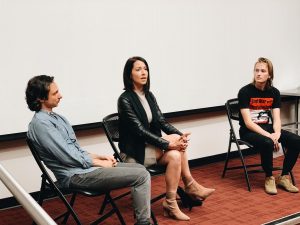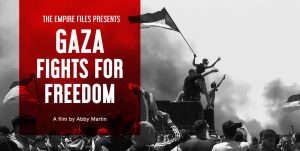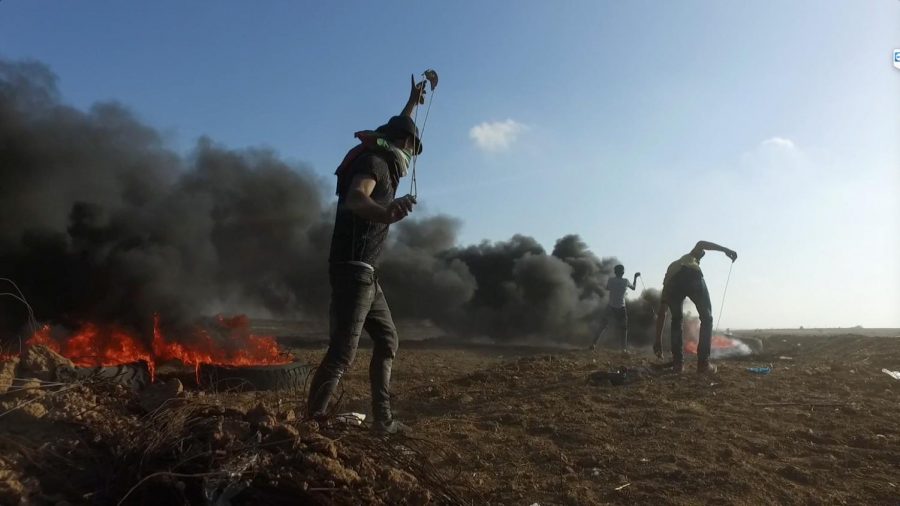The Gaza Fights for Freedom: Independent Documentary, Collective Cause
October 14, 2019
Lights at the concert blared outside the Union where students flooded into the gates to enjoy a night of music. Unnoticed, though, behind this chaos was a quieter gathering of Salt Lake residents including socialists, antiwar advocates, peace advocates and the generally curious. The subject — protests in Gaza against the oppressive Israeli government. Because what else would we be doing on a Wednesday night? Certainly not watching a documentary on one of the most controversial regions in the world.
The documentary was recently put together by journalist Abby Martin with veteran and antiwar advocate Michael Prysner. Martin is the voice behind “Empire Files,” a documentary and interview series that focuses on “a world shaped by war and inequality,” according to their website. Unsurprisingly, then, they were approached by Gaza journalists to do an episode on the violent situation in the Gaza Strip. “Nobody else is telling this story correctly,” they’d told them.
Martin directed the interviews with Prysner, and after receiving the footage, Martin said, “We knew that we had to take a step back from the production of Empire Files.” Instead, they went through the arduous process of creating a full-length documentary. “How could we not do what you just saw?” she asked. “How could we just do an episode about this? To do this story justice, to do their message justice, because people are dying. To tell the international community what is happening to them … it’s falling on deaf ears.”

Martin has had tension with governments in the past, which prevented her from visiting Gaza directly. There were claims that she was an Iranian agent, the mortal enemy of Israel. “It was really, really frightening to be told that,” she said. “But also I thought I was a Russian agent, and a Venezuelan agent, so I don’t even know where that claim came from.” This was met with laughter. Clearly, Martin has made her rounds and her enemies, but she doesn’t seem too concerned with the danger of these labels in light of the information she’s exposing. “Needless to say,” she said, “we’ll probably be banned for life, not only from Gaza but from Israel as well, which I wear as a badge of honor.”
The subject of the documentary hinged on the Great March of Return, a protest that held at the blockaded border at the edge of the Gaza Strip. The footage covers a slice of these weekly encounters, where Palestinians resist a heavily armed Israeli military with nothing but dance, burning kites and slingshots for stones. Martin, who also narrates the film, acutely points out how perfect a weapon this is in a David and Goliath story. This story ends, however, with the death of the first female medic in the March and a cry for action.
“The instinct of any filmmaker would be to have the climax be the March,” Prysner said. “Save the climax for the end, the dramatic showdown with the Israeli soldiers and build to it throughout, but we decided to do something different. We didn’t want to just make a film that was beautiful and made you sympathetic to one or two people — we wanted to produce a piece of journalism.” This means that their job revolved around uncovering insight that could stand against the narrative of powerful, influential media. “That was our first job,” he said, “to do an actual investigation, corroborating evidence and put together an irrefutable case for what happened. A case for justice.” They wanted to focus on a day in the life of Gaza by documenting a family living off of practically nothing, then zoom out to give perspective to the overarching situation before landing on the case of the young medic, Razan.
Razan, like a high number of individuals meant to be protected under UN law, was shot by the Israeli military in a protest in June. Her colleagues and mother were interviewed by The New York Times, which treated the incident as an anomaly and took her mother, Sabrine, out of context. Corporate media had smeared Razan, and for this reason, she was skeptical of the documentary, but they showed her the end result and she was relieved. They were not short on tragic stories, but because of the inaccurate representation, they wanted to clear her name specifically. “It’s not hard to show sadness in Gaza,” Prysner said, but he was also quick to remind us of what Sabrine told the cameras and the world. “We want more than sympathy, we want our rights.”

When the Great March sparked in 2018, the media took it with a passive voice. The area is controversial and taking sides creates precarious situations, as seen with Trump announcing Jerusalem as Israel’s capital. But this fear of unrest creates an image that the power of both the Israelis and the Palestinians, particularly those in Gaza, is equal. The media says that Palestinians died. “Well who’s killing them,” Martin said, horrified by the media’s approach. “How are they dying? They’re getting massacred.” Many American news outlets looked at this issue from the Israeli side — many outlets, and not just Fox News, spun the events to make it sound like the Gaza people planned to be killed.
Open your eyes to the truth. Isn’t that what we always hear? Well, we’re looking, eyes wide open, we just don’t know where to look and often it’s the same narrative in every corner. Prysner and Martin want this documentary to be a tool, not just something to look at, but a source to use in movements for human rights. They wanted to spare no expense, which is why you’ll see requests for donations. This is a difficult thing to overlook, especially with workers in Gaza who have been used to being paid extremely low wages. Martin and Prysner want to give them what they deserve. This film was entirely made through grassroots donations. Now they’re traveling around the country and taking the story with them.
It’s a powerful creation they’ve breathed life into and has a radical impact on perspective. Like all expressionistic and vulnerable art, it asks — what do you actually know?









Bob Brister • Oct 26, 2019 at 12:30 pm
Thank you for publishing this very good review of “Gaza Fights for Freedom”. I was at the showing and I thank the producers and those who organized the presentation at University of Utah. We need more films like this to understand the effect of U.S. support for Israel’s dispossession of the Palestinians.